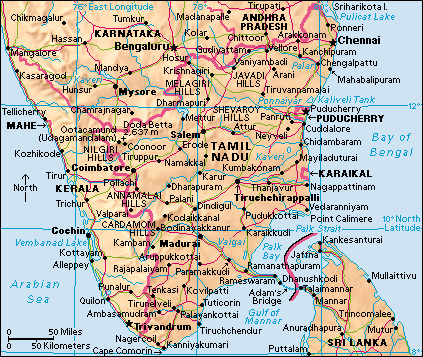Puducherry (pop. 1,247,953) is a union territory of southern India. The territory consists of four widely separated coastal districts with a combined area of 185 square miles (480 square kilometers). The largest of the four districts, Puducherry district, includes the port city of Puducherry, the capital of the territory. The districts of Karaikal, Puducherry, and Yanam lie on the southeast coast of India, while the Mahe district lies on the southwest coast. The four districts were once French colonies. The British defeated the French in a struggle to control India in the 1800’s, but the four districts remained under French rule until 1954.

The four districts of the territory of Puducherry are well cultivated and prosperous, with good links to other parts of southern India. Some French administrative, cultural, and judicial practices have survived from the colonial period. In addition, the Puducherry district is known for its ancient temples and monuments.
Most of the people who live in the territory of Puducherry are Hindus. The next largest groups are Christians and Muslims. Many languages are spoken in the territory, but only five are official. These languages are Tamil, Telugu, Malayalam, English, and French.
The main crops of the territory are cotton, peanuts, rice, and sugar cane. In the district of Mahe, coconuts are abundant.
Near the city of Puducherry lie the remains of a Roman settlement, Arikamedu, which was a center of trade between India and Rome in the A.D. 100’s and 200’s. The city later became a seat of traditional learning and Vedic culture and was named Vedapuri, after the worship of Vadapuriswara, the local name of the Hindu god Shiva. A temple to the god was built and rebuilt many times. The earliest remains date back to the A.D. 900’s. In the 900’s and 1000’s, the kings of the Chola Empire of southern India built temples around the city.
In 1673, the French set up a trading center at the city of Puducherry. This center eventually became the chief French settlement in India. Dutch and British trading companies also wanted trade with India. Wars raged between these European countries and spilled over into the Indian subcontinent.
The Dutch captured the city of Puducherry in 1693 but returned it to France by the Treaty of Ryswick in 1699. The French acquired Mahe in the 1720’s, Yanam in 1731, and Karaikal in 1738. During the Anglo-French wars (1742-1763), the city of Puducherry changed hands frequently. The British finally returned it to the French in 1814. When the British gained control of all of India in the late 1850’s, they allowed the French to retain their few settlements in the country, including the districts of Mahe, Karaikal, Puducherry, and Yanam.
By 1946, most of the people of the French colonies in India had begun to demand independence from France, and several political parties emerged. When it became known that the British would grant India independence in 1947, the people of the French colonies demanded to join free India. After independence, India began negotiating with France over the issue. In 1954, France allowed India to assume control over its remaining Indian colonies. But France did not formally hand over the territories to the Indian government until 1962.
In December 2004, a powerful undersea earthquake in the Indian Ocean near the Indonesian island of Sumatra generated a series of large ocean waves called a tsunami. The tsunami’s towering waves killed about 600 people and damaged much property in the Karaikal and Puducherry districts.
In October 2006, a law changing the territory’s name from Pondicherry, the colonial name for the territory, to Puducherry came into effect. Puducherry is the Tamil name of the region.
